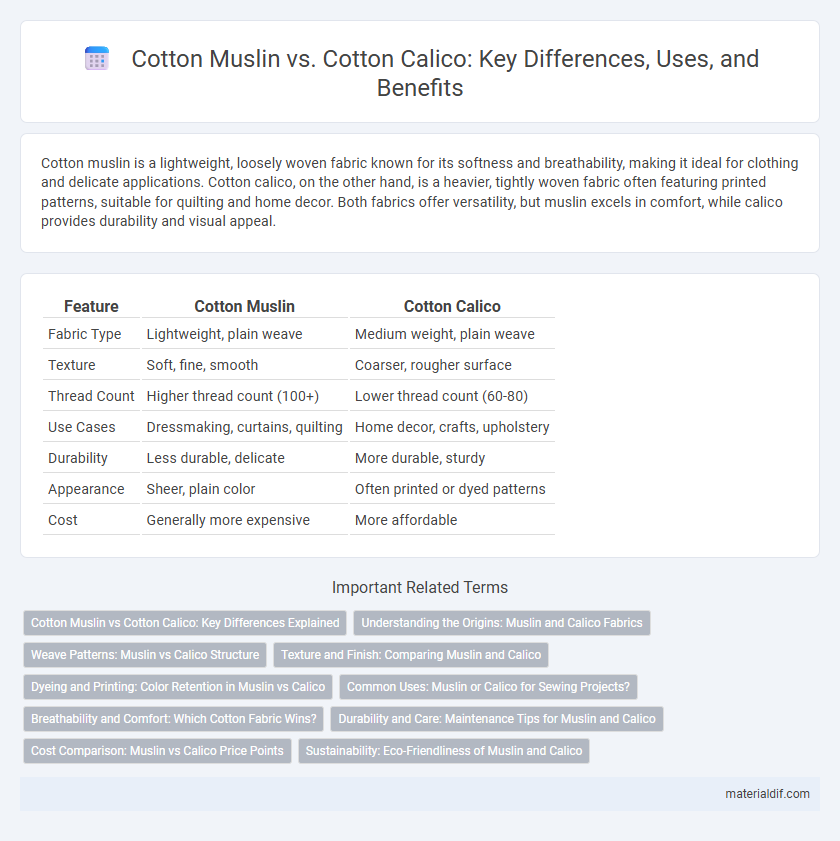Cotton muslin is a lightweight, loosely woven fabric known for its softness and breathability, making it ideal for clothing and delicate applications. Cotton calico, on the other hand, is a heavier, tightly woven fabric often featuring printed patterns, suitable for quilting and home decor. Both fabrics offer versatility, but muslin excels in comfort, while calico provides durability and visual appeal.
Table of Comparison
| Feature | Cotton Muslin | Cotton Calico |
|---|---|---|
| Fabric Type | Lightweight, plain weave | Medium weight, plain weave |
| Texture | Soft, fine, smooth | Coarser, rougher surface |
| Thread Count | Higher thread count (100+) | Lower thread count (60-80) |
| Use Cases | Dressmaking, curtains, quilting | Home decor, crafts, upholstery |
| Durability | Less durable, delicate | More durable, sturdy |
| Appearance | Sheer, plain color | Often printed or dyed patterns |
| Cost | Generally more expensive | More affordable |
Cotton Muslin vs Cotton Calico: Key Differences Explained
Cotton Muslin features a lightweight, breathable weave ideal for delicate garments and curtains, while Cotton Calico is a densely woven, sturdier fabric commonly used in quilting and home decor. Muslin has a softer texture and a more open weave compared to Calico's tighter construction and slightly rougher feel. The primary differences lie in their weave density, texture, and typical uses, with Muslin offering more drape and Calico providing greater durability.
Understanding the Origins: Muslin and Calico Fabrics
Cotton muslin originated in the Middle East and South Asia, prized for its lightweight, breathable texture and fine weave, making it ideal for delicate garments and draping. Cotton calico, developed in India and later produced in Europe, features a coarser, more tightly woven structure with printed patterns, commonly used for quilts, upholstery, and affordable clothing. Both fabrics share cotton as a base fiber but differ significantly in weave complexity, texture, and traditional applications, reflecting their distinct historical and geographic origins.
Weave Patterns: Muslin vs Calico Structure
Cotton muslin features a plain weave with a fine, lightweight, and loosely woven structure that allows for breathability and softness, ideal for delicate clothing and drapery. Cotton calico uses a denser plain weave, resulting in a thicker, sturdier fabric with a tighter structure often printed with small floral or geometric patterns, suitable for quilting and home decor. The key difference lies in muslin's open, airy weave compared to calico's compact, durable construction.
Texture and Finish: Comparing Muslin and Calico
Cotton muslin features a soft, lightweight texture with a loose weave that provides a smooth and breathable finish, making it ideal for garments and dressmaking. Cotton calico has a denser, coarser texture and a tighter weave, often resulting in a stiffer, more durable finish suitable for quilting and upholstery. The finish of muslin is generally soft and matte, while calico is slightly rougher with a natural, unbleached appearance.
Dyeing and Printing: Color Retention in Muslin vs Calico
Cotton muslin exhibits superior color retention during dyeing and printing due to its finer weave and smoother surface, allowing more even absorption of dyes and vibrant results. In contrast, cotton calico, with its coarser texture and denser weave, tends to absorb dyes less evenly, often resulting in a more muted color appearance and greater fading over time. The higher thread count in muslin also contributes to enhanced durability of printed patterns compared to the more porous calico fabric.
Common Uses: Muslin or Calico for Sewing Projects?
Cotton muslin is favored for lightweight sewing projects such as garment prototypes, linings, and curtains due to its soft texture and breathable qualities. Cotton calico, with its denser weave and durability, is commonly chosen for quilting, craft projects, and home decor items like cushion covers and tote bags. Selecting muslin or calico depends on project needs: muslin for drapability and softness, calico for sturdiness and print visibility.
Breathability and Comfort: Which Cotton Fabric Wins?
Cotton muslin offers superior breathability due to its lightweight, loosely woven structure, making it ideal for warm weather and sensitive skin. Cotton calico, with its denser weave, provides more durability but less airflow, which can result in reduced comfort during hot conditions. For optimal breathability and comfort, cotton muslin is the preferred choice among cotton fabrics.
Durability and Care: Maintenance Tips for Muslin and Calico
Cotton muslin, lightweight and loosely woven, requires gentle washing to prevent stretching and wear, making hand washing or cold machine cycles ideal for maintaining its softness and durability. Cotton calico, featuring a tighter weave and often printed designs, is more durable and can withstand regular machine washing at moderate temperatures without significant damage. Both fabrics benefit from air drying and minimal ironing to extend their lifespan while preserving texture and color vibrancy.
Cost Comparison: Muslin vs Calico Price Points
Cotton muslin typically commands a higher price point than cotton calico due to its finer weave and softer texture, making it preferred for delicate garments and premium home textiles. Calico, known for its coarser, heavier weave and affordability, is commonly chosen for everyday use, crafts, and quilting projects. The cost difference is influenced by manufacturing processes, fabric quality, and demand, with muslin often costing 15-30% more per yard compared to calico.
Sustainability: Eco-Friendliness of Muslin and Calico
Cotton muslin is often considered more eco-friendly due to its lightweight, breathable structure that requires less water and energy during production compared to the denser cotton calico fabric. Both fabrics are biodegradable and renewable, but muslin's minimal dyeing and chemical treatments lower its environmental impact. Calico, being heavier and more tightly woven, generally consumes more resources in processing, making muslin a preferred choice for sustainable textile options.
Cotton Muslin vs Cotton Calico Infographic

 materialdif.com
materialdif.com